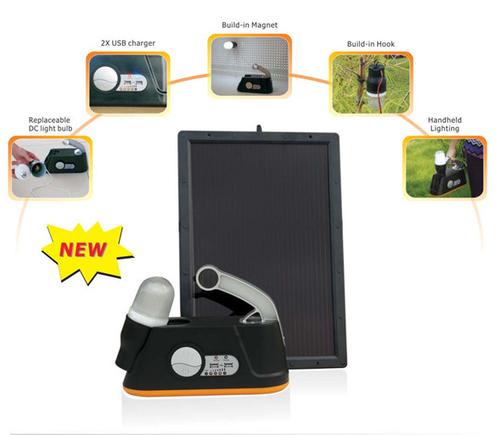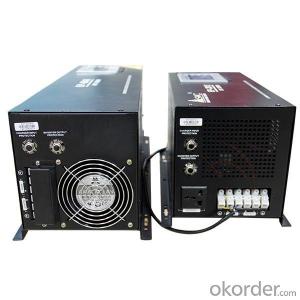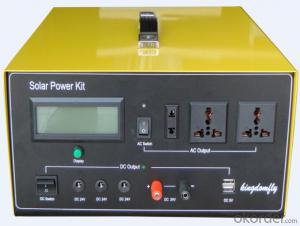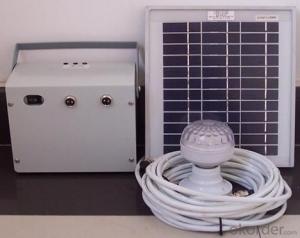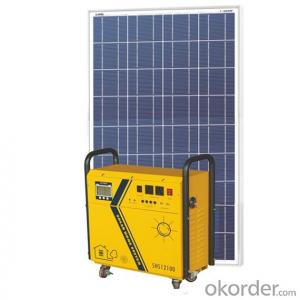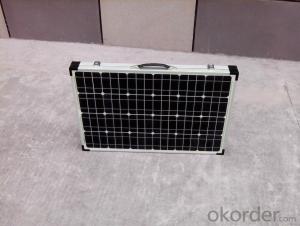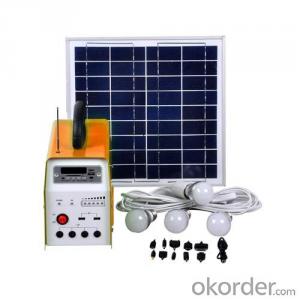Solar Energy Systems Nappanee - Solar Portable Power Kit 6W (TPS-201)
- Loading Port:
- China Main Port
- Payment Terms:
- TT or LC
- Min Order Qty:
- -
- Supply Capability:
- 50000sets m.t./month
OKorder Service Pledge
OKorder Financial Service
You Might Also Like
Product DescriptionDescription: TPS-201 6W Solar Portable Power Kit 1.Solar portable lighting kit for both indoor and outdoor use. Good for sheds, garage, camping 2.Replaceable energy saving/LED bulb provide bright lighting 3.Built-in magnet & hanging hook enables easy fixing of the bulb 4.USB output available to power mobile phones & other electronic devices alike 5.User friendly indicator for easy monitoring of the battery status. 6. 6W Amorphous solar panel + 12V/4.5AH Battery + one pcs 5W lighting with 3M cables + 2 pcs USB output (charging mobile phone) + Voltage indicater |
- Q: How do solar energy systems impact the reliability of the electricity grid?
- Solar energy systems can positively impact the reliability of the electricity grid by diversifying the energy sources. As solar power is a renewable and abundant resource, it can help reduce reliance on traditional fossil fuel-based power generation, thereby enhancing grid stability. Additionally, distributed solar installations can reduce strain on the transmission infrastructure and decrease the risk of blackouts by providing power closer to where it is consumed. However, intermittent nature of solar energy may require effective grid management and energy storage solutions to ensure consistent power supply during periods of low sunlight.
- Q: How does the performance of solar panels vary based on the type of installation?
- The performance of solar panels can vary based on the type of installation due to factors such as the orientation and tilt of the panels, shading from nearby objects, and the quality of installation. A well-designed and properly installed solar panel system can maximize exposure to sunlight and optimize energy generation, resulting in higher performance. On the other hand, inadequate installation or poor positioning can reduce efficiency and lead to lower performance.
- Q: What is the impact of shading from nearby trees or buildings?
- The impact of shading from nearby trees or buildings can vary depending on the specific situation. In general, shading can provide relief from direct sunlight, reducing heat gain and providing a more comfortable environment. However, excessive shading can limit the amount of natural light entering a space, potentially leading to dark and gloomy interiors. Additionally, shading can affect the growth and health of plants, as they may not receive adequate sunlight for photosynthesis. Proper management of shading is crucial to balance the benefits of shade with the potential drawbacks.
- Q: What is the expected maintenance cost of a solar energy system?
- The maintenance cost of a solar energy system can differ depending on various factors. However, when compared to other methods of generating energy, the maintenance cost of a solar energy system is generally low. Solar panels, which are the crucial component of a solar energy system, are usually designed to be durable and require minimal maintenance. They are constructed to withstand different weather conditions and can last for many years with proper care. However, occasional maintenance may be necessary to ensure optimal performance. The maintenance requirements for a solar energy system typically involve cleaning the panels to remove any dirt, dust, or debris that may accumulate over time. This can be done by using water and a soft brush or with the assistance of automated cleaning systems. It is recommended to clean the panels at least once or twice a year, although this can vary depending on the location and environmental factors. Alongside cleaning, regular inspections of the solar energy system are also vital. This involves checking for any signs of damage, loose connections, or potential issues with the electrical wiring. Inspections can be carried out by the system owner or a professional solar installer, and they are generally done annually. On the whole, the expected maintenance cost of a solar energy system can be relatively low, typically ranging from 0.5% to 1% of the total installation cost per year. This cost mainly covers expenses for cleaning, inspections, and any minor repairs that may be necessary. However, it is important to note that the actual maintenance cost can vary depending on the system's size, location, and specific maintenance requirements. In conclusion, while there are some maintenance tasks associated with a solar energy system, the expected cost is generally low compared to other energy systems. With proper care and regular inspections, a solar energy system can continue to produce clean and renewable energy for many years with minimal maintenance expenses.
- Q: Can solar energy systems be used for waste management?
- Yes, solar energy systems can be used for waste management. Solar energy can power various waste management processes such as waste-to-energy conversion, landfill gas extraction, and waste water treatment. By utilizing solar power, these systems can reduce reliance on traditional energy sources, lower carbon emissions, and contribute to a more sustainable waste management approach.
- Q: Are there any risks of electrical arcing with solar energy systems?
- Yes, there are risks of electrical arcing with solar energy systems. Electrical arcing occurs when there is a breakdown in the insulation of electrical components, resulting in the flow of electricity through air or other non-conductive materials. This can lead to a fire hazard and damage to the solar energy system. Some potential causes of electrical arcing in solar energy systems include faulty wiring, loose connections, and damage to the solar panels. These issues can result in an increased risk of electrical arcing, which can cause overheating, melting of components, and even electrical fires. To mitigate the risks of electrical arcing, it is crucial to ensure that the solar energy system is installed and maintained by qualified professionals who follow industry standards and regulations. Regular inspections and maintenance should be conducted to identify and address any potential issues that could lead to electrical arcing. Furthermore, the use of high-quality electrical components and proper grounding techniques can help reduce the risk of electrical arcing. Implementing safety measures such as circuit breakers, surge protectors, and arc fault circuit interrupters (AFCIs) can also provide additional protection against electrical arcing. In summary, while solar energy systems offer numerous benefits, it is important to be aware of the potential risks of electrical arcing. By ensuring proper installation, maintenance, and adherence to safety guidelines, the risks can be minimized, allowing for the safe and efficient operation of solar energy systems.
- Q: Are there any risks of electrical shocks during installation or maintenance of solar energy systems?
- Yes, there are risks of electrical shocks during the installation or maintenance of solar energy systems. These risks can occur due to the high voltage of the system, improper grounding, faulty wiring, or inadequate safety precautions. It is crucial to follow proper safety procedures, use appropriate personal protective equipment, and ensure that qualified professionals handle the installation and maintenance to minimize the risk of electrical shocks.
- Q: What is the role of solar energy in achieving energy independence?
- The role of solar energy in achieving energy independence is crucial. Solar power is a renewable and abundant source of energy that can be harnessed to generate electricity and heat. By utilizing solar energy, nations can reduce their reliance on fossil fuels and imported energy sources, thereby achieving greater energy independence. Solar panels installed on rooftops, in fields, and in solar farms can produce clean and sustainable electricity, reducing the need for traditional power plants. Additionally, solar energy can be utilized in off-grid areas, allowing communities to generate their own power and become self-sufficient. Overall, solar energy plays a vital role in diversifying energy sources, reducing greenhouse gas emissions, and ensuring a more sustainable and independent energy future.
- Q: Can solar energy systems be used in areas with limited skilled labor?
- Yes, solar energy systems can be used in areas with limited skilled labor. Solar energy systems are designed to be user-friendly and require minimal technical expertise for installation and maintenance. Additionally, there are various training programs and resources available that can help train local individuals in the installation and maintenance of solar energy systems, enabling them to acquire the necessary skills. This allows for the adoption of solar energy in areas with limited skilled labor, promoting renewable energy usage and providing economic opportunities for the local population.
- Q: Can a solar energy system be installed in an area with limited sunlight?
- Yes, a solar energy system can still be installed in an area with limited sunlight. While solar panels are most efficient in areas with ample sunlight, they can still generate electricity in areas with limited sunlight. Even on cloudy or overcast days, solar panels can capture and convert some sunlight into electricity. Additionally, advancements in solar technology have improved the efficiency of solar panels, allowing them to generate power even in low-light conditions. However, it is important to note that the overall energy output of a solar energy system will be lower in areas with limited sunlight compared to areas with abundant sunlight. It is advisable to conduct a feasibility study to determine the potential energy output and cost-effectiveness of installing a solar energy system in an area with limited sunlight. Factors such as the angle and orientation of the panels, shading from surrounding buildings or trees, and the local climate should also be considered when assessing the viability of installing a solar energy system in an area with limited sunlight.
1. Manufacturer Overview
| Location | Shenzhen,China |
| Year Established | 2002 |
| Annual Output Value | Above US$80 Million |
| Main Markets | Europe, North America, Africa and Asia. |
| Company Certifications |
2. Manufacturer Certificates
| a) Certification Name | |
| Range | |
| Reference | |
| Validity Period |
3. Manufacturer Capability
| a) Trade Capacity | |
| Nearest Port | Shenzhen shekou |
| Export Percentage | 90% |
| No.of Employees in Trade Department | 200-300People |
| Language Spoken: | English;Chinese; |
| b) Factory Information | |
| Factory Size: | Above 300,000 square meters |
| No. of Production Lines | Above 10 |
| Contract Manufacturing | OEM Service Offered;Design Service Offered |
| Product Price Range | Average |
Send your message to us
Solar Energy Systems Nappanee - Solar Portable Power Kit 6W (TPS-201)
- Loading Port:
- China Main Port
- Payment Terms:
- TT or LC
- Min Order Qty:
- -
- Supply Capability:
- 50000sets m.t./month
OKorder Service Pledge
OKorder Financial Service
Similar products
Hot products
Hot Searches
Related keywords

